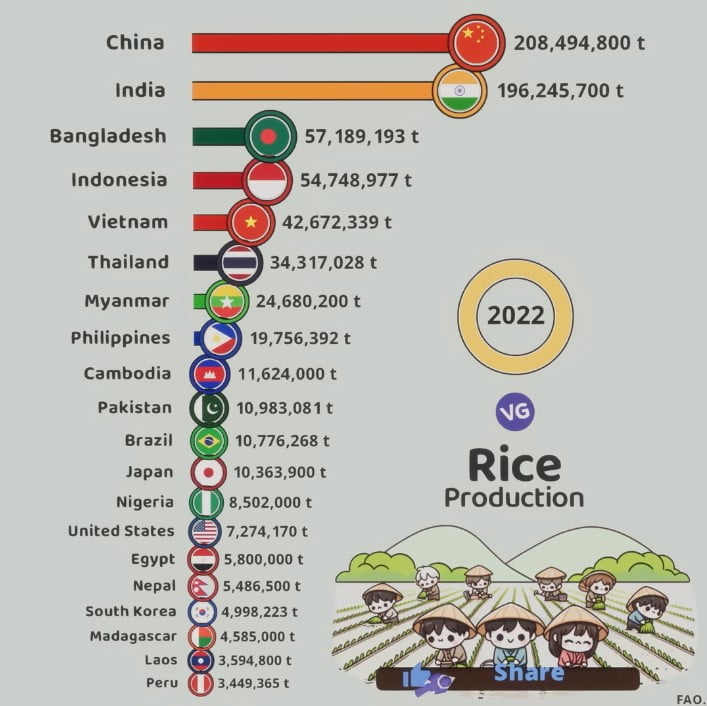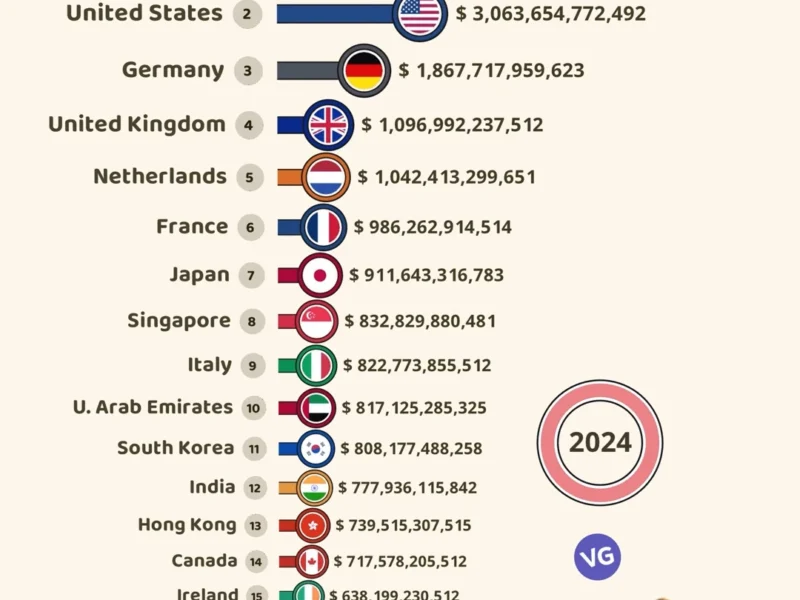Rice is key for over half the world’s people to eat, especially in Asia, Sub-Saharan Africa, and South America.1 It mostly comes from a plant called Oryza sativa. This plant started in Asia and is from the grass family. To grow rice well, you need warm days, cool nights, plenty of water, smooth land, and a hard subsoil layer. This makes sure the water stays put. People grow and trade types like Indica, Aromatic (jasmine and basmati), Japonica, and Glutinous rice.
The Biggest Rice Producer in World 2022
| Country | Flag | Rice Production (tonnes) |
|---|---|---|
| China | 🇨🇳 | 208,494,800 |
| India | 🇮🇳 | 196,245,700 |
| Bangladesh | 🇧🇩 | 57,189,193 |
| Indonesia | 🇮🇩 | 54,748,977 |
| Vietnam | 🇻🇳 | 42,672,339 |
| Thailand | 🇹🇭 | 34,317,028 |
| Myanmar | 🇲🇲 | 24,680,200 |
| Philippines | 🇵🇭 | 19,756,392 |
| Cambodia | 🇰🇭 | 11,624,000 |
| Pakistan | 🇵🇰 | 10,983,081 |
| Brazil | 🇧🇷 | 10,776,268 |
| Japan | 🇯🇵 | 10,363,900 |
| Nigeria | 🇳🇬 | 8,502,000 |
| United States | 🇺🇸 | 7,274,170 |
| Egypt | 🇪🇬 | 5,800,000 |
| Nepal | 🇳🇵 | 5,486,500 |
| South Korea | 🇰🇷 | 4,998,255 |
| Madagascar | 🇲🇬 | 4,585,000 |
| Laos | 🇱🇦 | 3,594,800 |
| Peru | 🇵🇪 | 3,449,365 |
Key Takeaways
- Rice is the primary staple food for more than half the world’s population.
- Oryza sativa is the primary rice species, originating in Asia.
- Economically sound rice production requires specific environmental conditions.
- Four major types of rice are produced and traded globally.
- Asia, Sub-Saharan Africa, and South America are the largest rice-consuming regions.
Introduction to Rice Cultivation
Rice is the main food source for over half of the world.2 It gives more than 20% of the calories we eat globally.2 You’ll find it’s a critical part of diets in Asia, Latin America, Africa, and the Caribbean.2
Importance of Rice as a Staple Food
About half of the world’s people rely on rice as their main food.2 It’s especially key for folks in Asia, Sub-Saharan Africa, and South America.3
Global Rice Consumption and Production
Rice Production by Country (2022)
Source: FAO, 2022
In 2019, we made 756 million tonnes of rice worldwide.2 It’s the third most grown crop after sugarcane and corn.2 The main types of rice are Indica, Aromatic, Japonica, Glutinous, and other specialty kinds. Indica is the most traded, making up 62-66% of the market.3
Rice grows differently in each place, with yields ranging from 700 to 4,000 kg per hectare.2 Over 90% of rice comes from Asia. China, India, Indonesia, and Bangladesh are the biggest producers.2
| Characteristic | Percentage |
|---|---|
| Indica Rice | 62-66% |
| Aromatic Rice | 23-25% |
| Japonica Rice | 9-10% |
| Glutinous and Other Specialty Rice | 2-3% |
Rice Production by Country
Just ten countries make up 85% of the world’s rice.1 China and India lead, producing over half of the global rice. They make 208.5 and 196.2 million tonnes in 2022.1
China: The Largest Rice Producer
In 2022, China led rice production with 208.5 million tonnes, more than a quarter of the world’s rice.1 Its production has been climbing, hitting 749.2 million tonnes in 2019 and 776.5 in 2022.1
India: The Second-Largest Rice Producer
India holds the second spot with 196.2 million tonnes produced in 2022.1 Its production has also been on the rise, from 216 million in 1961 to 776.5 globally in 2022.1
Other Leading Rice-Producing Countries
Bangladesh, Indonesia, and Vietnam follow with 57.2, 54.7, and 42.7 million tonnes, respectively.1 China, India, and these three form a huge part of the rice production worldwide.1
| Country | Rice Production (million tonnes) |
|---|---|
| China | 208.5 |
| India | 196.2 |
| Bangladesh | 57.2 |
| Indonesia | 54.7 |
| Vietnam | 42.7 |
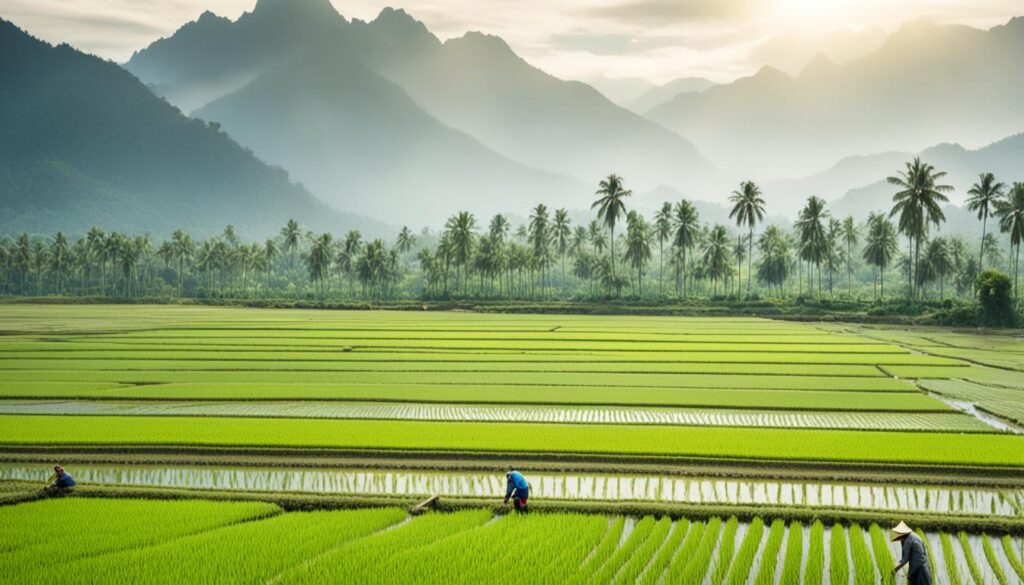
largest producer of rice in the world
China leads the world in rice production. It produced over 208 million tonnes in 2022. This is more than a quarter of the total rice produced globally.1 India comes in second, making about 196 million tonnes.1 These two countries together provide over half of the world’s rice.1
Rice from the Indica variety, grown in warm places, makes up 62–66% of the rice traded worldwide.3 Aromatic kinds such as jasmine and basmati from Thailand, Vietnam, and India, account for 23–25% of the market.3 Japonica rice, from cooler areas like Japan and some parts of China, represents 9–10% of the global trade.3 Specialty types, including glutinous rice from Southeast Asia, are about 2-3% of the industry.3
Factors Influencing Rice Production
Rice needs the right environment to grow well. This includes hot days, cool nights, lots of water, flat land, and a hard subsoil. This hard-pan helps keep water in.3 Water control is key since rice fields are flooded.
Climate and Soil Requirements
To grow rice, you need places with hot days and cool nights. Enough water is a must. Also, the ground should be flat and have a hard layer below. This stops too much water going down.3
Irrigation and Water Management
Rice fields are flooded, so water management is very important. Using the right irrigation and saving water are vital. This makes sure water is used well and without waste.3
Agricultural Practices and Technology
Getting better at farming has helped grow more rice. New types of rice, machines, and smart farming help a lot. These methods also help protect the environment.34
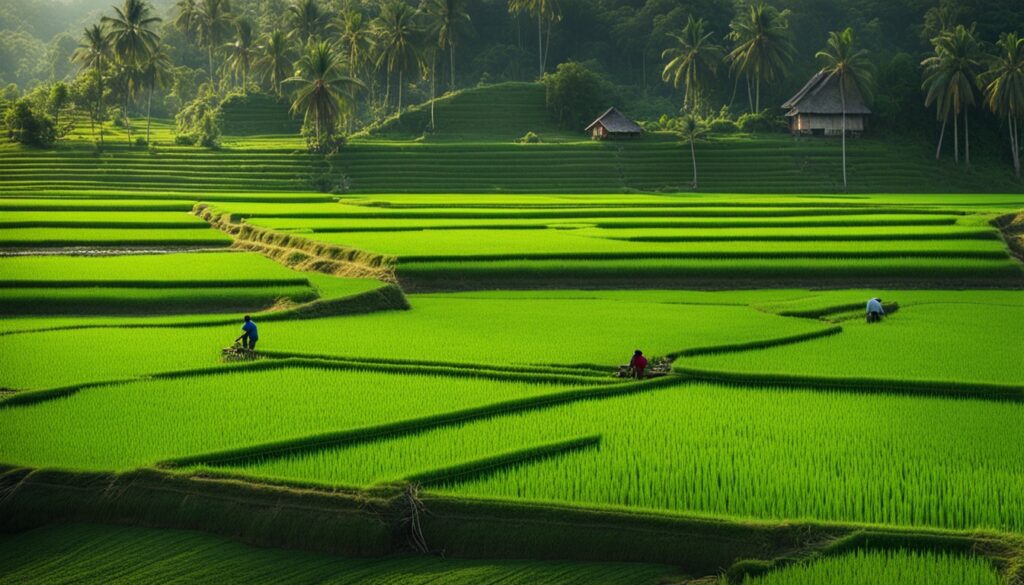
The U.S. is good at growing rice thanks to near Canadian potash, good soil, and rivers for easy shipping. This helps the U.S. do well with rice until 2024, at least.4
| Factor | Impact on Rice Production |
|---|---|
| Climate | High daytime temperatures, cooler nights, and ample water supply are essential for optimal rice cultivation.3 |
| Soil | A smooth land surface and a subsoil hard-pan that prevents excessive water percolation are crucial for rice production.3 |
| Irrigation and Water Management | Proper irrigation techniques and water conservation practices are necessary to ensure a sustainable and efficient use of water resources for rice cultivation.3 |
| Agricultural Practices and Technology | Improved rice varieties, mechanization, and efficient farming techniques have contributed to increased yields and reduced environmental impact.34 |
Rice Varieties and Types
There are four main types of rice in the world, including Indica and Aromatic (jasmine and basmati). The others are Japonica, and Glutinous along with other specialty types.3
Indica Rice
Indica rice is grown in warm places like India, Pakistan, and Thailand. It makes up a big part of the rice traded globally, around 62-66%.3
Japonica Rice
Japonica rice comes from cooler regions like Japan and South Korea. It accounts for 9-10% of the rice traded worldwide.3
Aromatic and Specialty Rice
Aromatic rice comes mainly from Thailand, Vietnam, and India and makes up 23-25% of global trade.3 Specialty rice types, like glutinous rice, from places such as Thailand and Vietnam. They make up about 2-3% of the world’s rice trading.3
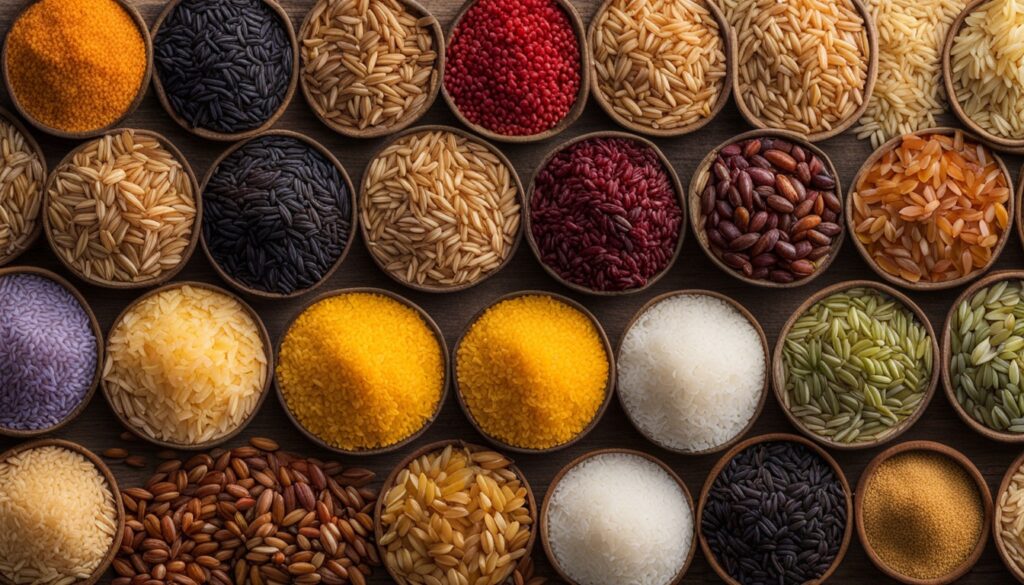
Across the globe, there are over 40,000 cultivated rice types. These are stored in the International Rice Gene Bank, with over 90,000 samples. The most common types of rice globally are Indica and Japonica.5
| Rice Variety | Characteristics | Key Producing Regions |
|---|---|---|
| Basmati Rice | A type of long-grain rice with a distinctive aroma and flavor | India, Pakistan |
| Bomba Rice | Can absorb three times its volume in liquid, ideal for paella | Spain |
| Brown Rice | Retains more vitamins, minerals, and fiber compared to white rice | Globally Produced |
| Carnaroli Rice | Favored for making risotto due to its high starch content | Italy |
| Easy Cook Rice | Undergoes a steaming process before milling, retaining nutrients | Globally Produced |
| Japonica Rice | Typically found in cooler climates, commonly used in Japanese and Caribbean cuisines | Japan, South Korea, California, Italy, USA |
| Jasmine Rice | Has a soft and slightly sticky texture when cooked, distinct from other long-grain rices | Thailand |
| Carolino Rice | Remain firm when cooked, ideal for stews and seafood dishes | Portugal |
| Ponni & Sona Masoori Rice | Non-aromatic with a fluffy and slightly starchy quality | India |
| Regular Long-Grain Rice | Versatile with a subtle flavor and fluffy texture when cooked | Globally Produced |
| Ribe Rice | Suitable for boiling, steaming, or as part of rice salads | Italy |
| Roma Rice | Long grains that release considerable starch, suitable for creamy risottos | Italy |
| Short-Grain Rice | Typically round and moist when cooked, perfect for desserts and sushi | Globally Produced |
| Vialone Nano Rice | Provides a creamy risotto texture, absorbing liquid while maintaining shape | Verona, Italy |
Basmati rice is a popular type of rice that the UK imports from India and Pakistan. It’s known for being long-grain and has a unique flavor and smell. This is because of a compound called 2-acetyl 1-pyrroline.5
Rice Trade and Exports
The United States stands as a key player in the rice market, with consistent supply. Despite producing less globally, it covers nearly 5% of the market. Other big players in rice exports are India, Thailand, Pakistan, and Vietnam. Together, they exported nearly $16 billion of rice in 2019.36
Major Rice Exporting Countries
India takes the lead as the world’s top rice exporter. With Thailand, Pakistan, and Vietnam, they make up the core exporting group. In 2019, these countries shipped almost $16 billion of rice, standing out in the global market.76
Rice Import Patterns and Demand
Many nations, from Iran to the Philippines, depend on rice imports. Sub-Saharan Africa leads the world in importing rice, followed by Southeast Asia. In the U.S., Asian rice types such as jasmine and basmati dominate imports. The U.S. is highly competitive and imports significant amounts.7
The U.S. has seen its rice imports grow significantly since the ’90s. Today, over 25% of its market is from imports, mainly aromatic varieties. It is the leading importer in the Americas, bringing in around 1.3 million tons.37
About 52-56% of U.S. rice exports are milled, along with a good amount of rough rice. U.S. long-grain brown rice also has a market in Western Europe. This shows the variety the U.S. market can offer.37
In the global market, Latin America brings in 9–10% of all rice imports. Australia, on the other hand, exports 200,000–300,000 tons of mainly medium- and short-grain rice each year.7
Environmental Impact of Rice Cultivation
Rice farming has a big effect on the environment. It uses a lot of water and releases many greenhouse gases.8 In fact, 70% of the water used in farming goes to grow rice. And it causes 30% of the gases that harm our atmosphere from agriculture.9 But, there are ways to grow rice that are better for the planet. These methods aim to use less water and reduce gas emissions.
Water Consumption and Greenhouse Gas Emissions
Rice fields need much water and produce lots of dangerous gases.9 The way rice is grown can change how much methane and nitrous oxide it releases. For example, managing the straw, water, and fertilizers can make a big difference9.
Some fertilizers and ways of handling water can lower these harmful gas amounts. So, picking the right farming methods is key to lessening the bad effects on our environment9.
Sustainable Rice Farming Practices
To make rice farming better for the planet, we’re trying new methods8. The System of Rice Intensification (SRI) is one way. It boosts yields and cuts down on water use and gas emissions significantly8. This is especially beneficial for small or local farmers.
There are other environmentally friendly farming methods too. They might use special types of fertilizer or include the use of natural materials. These methods focus on reducing harmful gases from rice fields9. Some even blend the leftover crops with rice straw to lessen the bad effects on our environment9.
The best way to farm rice sustainably can differ by where you are and how much rice you grow. Understanding the best methods helps protect the environment, making it more resilient against climate change8. Plus, it ensures there is enough food for everyone in the long run8.
Rice Production Trends and Challenges
The world’s population keeps growing, so more rice is needed. This increases the challenge of keeping everyone fed.6 Currently, rice is vital for more than half of us, offering over one-fifth of the calories we eat worldwide.6 With an expected population of 9.7 billion by 2050, ensuring we have enough rice is now critical.6
Population Growth and Food Security
With more people, the demand for rice keeps rising.6 Rice, a key source of calories globally, will play a huge role in feeding us.6 But, meeting this demand and keeping our food supply safe is a big challenge for rice-producing areas.
Climate Change and Natural Disasters
Climate change and disasters like droughts and floods are hurting rice farms.6 For poorer nations, 8-26% of their rice may be lost after it’s harvested.6 These issues disturb rice farming, leading to less rice and a shaky global supply.
Technological Advancements in Rice Farming
New technologies in rice farming can help tackle these issues. They’re crucial for a reliable and sustainable future supply of rice.3 High-yield, climate-resistant rice, precise farming, and better post-harvest methods are key. They boost rice farming and fight the effects of climate change and disasters.3
Conclusion
Rice is eaten by many people around the world, mainly in Asia, Sub-Saharan Africa, and South America.2 China and India make most of the rice in the world, more than 50%.10 Yet, growing rice causes a lot of harm to the environment because it uses a lot of water and produces greenhouse gases.2 With our population growing and climate change happening, we need to find better ways to grow rice. This will make sure we have enough without hurting our world.10
In Africa, the need for rice will go up a lot, from 12.3 million tons to 15.4 million tons by 2026.10 Their population will also increase, with more than 1.2 billion people by then.10 Even though the economy in Africa is getting better, the money each person has is still low, around $1,690. This is less than other places in the world.10
As the world wants more and more rice, it’s important to grow it in ways that don’t harm the Earth. We can use new technologies and better ways to use water. These steps are key to a future where rice is both available and good for the planet, for us and for those who will come after us.
FAQ
What is the largest producer of rice in the world?
China is the lead producer of rice, making over 208 million tonnes in 2022. This is more than a quarter of the world’s total.
Who are the top two largest producers of rice in the world?
China and India stand as the top producers. They make more than half the world’s rice. In 2022, China produced 208.5 million tonnes, while India produced 196.2 million tonnes.
What are the major types of rice produced and traded worldwide?
The four major types of rice are Indica, Aromatic (including jasmine and basmati), Japonica, and Glutinous. These, along with other specialty types, are traded across the globe.
Which countries are the major rice exporting countries?
India, Thailand, Pakistan, and Vietnam are the key rice export countries. In 2019, they collectively exported nearly billion worth of rice.
What are the environmental concerns associated with rice cultivation?
Rice farming uses 70% of the world’s agricultural water. It also generates 30% of farming’s greenhouse gas emissions. These stats raise critical environmental issues.
What are the challenges facing global rice production?
Global rice farming faces several issues. These include growing populations, climate change, and natural disasters. To overcome these challenges, the rice industry must improve its technology and adopt sustainable farming methods.
Source Links
- https://en.wikipedia.org/wiki/List_of_countries_by_rice_production
- https://www.britannica.com/plant/rice
- https://www.ers.usda.gov/topics/crops/rice/rice-sector-at-a-glance/
- https://www.farmprogress.com/rice/7-factors-affecting-the-rice-market
- https://www.riceassociation.org.uk/types-of-rice
- https://www.weforum.org/agenda/2022/03/visualizing-the-world-s-biggest-rice-producers/
- https://www.ers.usda.gov/topics/crops/rice/trade/
- https://foodprint.org/blog/environmental-impacts-of-rice-production/
- https://www.scirp.org/journal/paperinformation.aspx?paperid=59054
- https://www.ers.usda.gov/amber-waves/2017/october/sub-saharan-africa-is-projected-to-be-the-leader-in-global-rice-imports/

